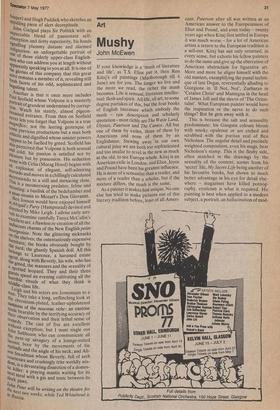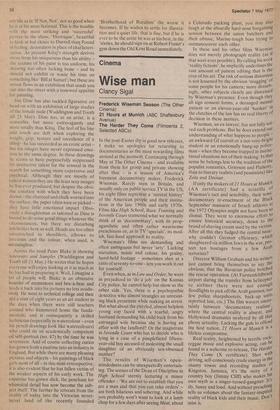Art
Mushy
John McEwen
If your knowledge is a 'mush of literature and life', as T.S. Eliot put it, then Ron Kitaj's oil paintings (Marlborough till 4 June) are for you. The longer we live and the more we read, the richer the mush becomes. Life is sensual, literature intellectual: flesh and spirit.
All life, all art, to some degree partakes of this, but the four books of English literature which embody the mush — raw description and scholarly quotation— most richly are The Waste Land, Ulysses,. Paterson and The Cantos. All but one of them by exiles, three of them by Americans and none of them by an Englishman. Stewing away in our own cultural juice we are both too sophisticated and too insular to revel in the new as much as the old, to see Europe whole. Kitaj is an American exile in London, and Eliot, Joyce and Pound have been his greatest influence. He is more of a sensualist than a reader, and more of a reader than a scholar, but if the mixture differs, the mush is the same. As a painter it makes him unique. No one else has tried to make pictures out of this literary tradition before, least of all Amen cans. Paterson after all was written as an American answer to the Europeanness of Eliot and Pound, and even today — twenty years ago when Kitaj first settled in Europe it was much worse,— for a lot of American artists a return to the European tradition is a sell-out. Kitaj has not only returned, in every sense, but exhorts his fellow painters to do the same and give up the aberration of American abstraction for figurative art. More and more he aligns himself with the old masters, exemplifying the pastel technique of late Degas, reverentially alluding to Giorgione in `If Not, Not', Zurbaran in 'Catalan Christ' and Mantegna in the head of James Ioll and the sleeve of 'The Orientalist'. What European painter would have the inspiration or the nerve to do such things? But he gets away with it.
This is because the salt and sensuality predominate: his Gauguin colours bloom with smoky opulence or are etched and scrubbed with the puritan zeal of Ben Nicholson. The angular detail and precisely weighted composition, even his mugs, bear Nicholson's stamp. This is the fleshy side, often matched in the drawings by the sexuality of the content, scenes from his 'secret' life, My Secret Life being another of his favourite books, but shown to much better advantage in his .eye for detail elsewhere — magazines have killed pornography, eroticism is what is required. His painting is best when applied to a modern subject, a portrait, an hallucination of mod ern life as in If Not, Not', not so good when he is at his most fictional. This is the trouble
with the most striking and 'successful' picture in the show, `Moresque', beautiful to look at but closer to Durrell than Pound
i it feeling, decoration in place of chailcterisation. At present Kitaj's strength derives more from his uniqueness than his ability —
the texture of his paint is too uniform, his drawing too often lacking bone — and he should not exhibit or waste his time on something like 'Bill at Sunset'; but these are minor flaws in an exhibition that sends you out into the street with a renewed appetite for painting.
Jim Dine has also tackled figurative art head on with an exhibition of large studies of the female nude (Waddington and Tooth till 21 May). Dine too, as an artist, is a sensualist, but more extravagantly and more totally than Kitaj. The feel of his line and touch are deft when exploring the weight, grip, texture and succulence of a t hing — he has succeeded as an erotic artist — but his images have never expressed emotion to the same degree. In these drawings he seems to have purposefully suppressed his instinctive talent for the sensual in the search for something more expressive and psychical. Although they are mostly of naked women they are the least sexy images he has ever produced, but despite the obvidus emotion with which they have been drawn — the charcoal and chalk worried into the surface, the paper often torn or picked — they have little emotional impact. Obviously a draughtsman as talented as Dine is bound to do some good things whatever the circumstances, but there are disturbing infelicities here as well. Heads are too often misattached to shoulders, elbows to forearms and the colour, when used, is meaningless.
Across the road Peter Blake is showing Souvenirs and Samples (Waddington and Tooth till 21 May.) He writes that he hopes everyone will enjoy looking at it as much as he has had in preparing it. Well, I imagine a lot of people will. Blake is an obsessive hoarder of mementoes and bric-a-brac and feeds it back into his pictures no less assiduously. He went to technical college and then did a stint of eight years as an art student in the days when there were still teachers around who hammered home the fundamentals; and is consequently a skilled technician (especially in watercolour — even his pencil drawings look like watercolours) who could do an academically competent oil self-portrait (no. 47) by the time he was seventeen. And of course collecting curios has grown from a pastime into an industry in England. But while there are many pleasing pictures and objects — his paintings of black girls most of all — in this mini-retrospective, it is also evident that he has fallen victim of the weaker aspects of his early work. The expertise has grown slick, the penchant for whimsical detail has now become the subject itself. The further he retreats from the reality of today into the Victorian nevernever land of the recently founded
'Brotherhood of Ruralists' the worse it becomes. If he wishes to settle for illustration and a quiet life, that is fine, but if he is ever to be the artist he was at his best, in the 'sixties, he should sign on at Robert Fraser's gym down the Old Kent Road immediately.







































 Previous page
Previous page